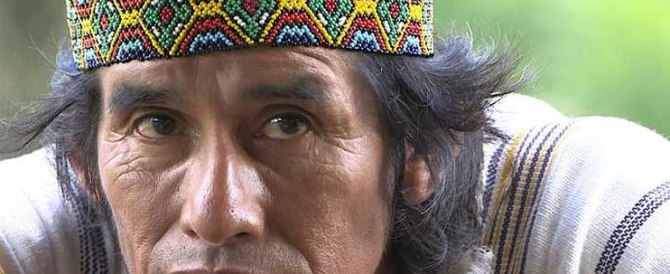The bodies of Edwin Chota and his three colleagues were discovered on a jungle path deep within the Amazon, near the point where Peru cedes to Brazil. The four Peruvians were trekking to Brazil to meet fellow tribesmen and discuss how to expel gangs of illegal loggers from their ancestral lands. In the dense rainforest the men’s murderers had the perfect cover. Vultures arrived at the scene days before the search party.

“Welcome to the land without law,” Edwin Chota told a journalist in 2011, gesturing to the forest he inhabited. “The only law here is the law of the gun.” Last month, after years of death threats from the timber traffickers he pitched himself against, Chota received a bullet to the head.
The wood from a single mahogany tree from Peru’s Amazon can fetch $11,000on the US market. As a result illegal logging there is prolific, accounting for an estimated 80 percent of the country’s exports. From the New York Times to National Geographic, Chota received international acclaim for denouncing the devastating impacts this black market had on the way of life of local communities. News of his death travelled further still.
Chota’s is a compelling tale of nature versus power. He was a brave indigenous chief who took on the timber mafia, whose appeals to the state administration for support were habitually ignored, and who ultimately lost his life defending the environment that sustained him and thousands of others.
What is rarely reported is that stories like Chota’s find echoes the world over.
In 2012, indigenous leader Jimmy Liguyon was shot dead in front of his family in the Philippines, reportedly for refusing to sign away his land to miners. José Cláudio Ribeiro da Silva and his wife Maria were assassinated by masked gunmen in Brazil in 2011 after having denounced the encroachment of loggers into their reserve. In 2012 in Cambodia, 14-year-old Hen Chantha was shot dead by military police who were evicting her village to make way for a rubber plantation.
These deaths and hundreds more like them are catalogued in a report Global Witness published earlier this year. Deadly Environment is the most comprehensive global analysis to date of the known killings of a large, yet little-known group of people – land and environmental defenders. On average two of them are killed every week.
The environment is emerging as a new battleground for human rights. As demand for products like timber, beef, palm oil and rubber intensifies, governments, companies and bootleggers are increasingly exploiting land with little regard for the people who live on it.
Often the law of the gun reigns. A large number of the environmental defenders whose deaths featured in public records over the past decade – approaching 1000 – were killed when state or private security forces fired on protesters, but many died at the hands of hired assassins.
Brazil is the deadliest country to be an environmental defender, accounting for around half of reported cases. The deaths of 93 people in a single valley put Honduras in second place, followed by the Philippines, Peru and Colombia. More often than not victims are members of indigenous groups, and overall Latin America and Asia-Pacific are the worst-affected regions.
Given the remoteness of many of these killings, the fear and secrecy that surround them, and the fact that many happen in places where human rights reporting is prevented, the death toll is likely to be far higher than public records suggest. Stunningly, only one per cent of recorded cases ever end in convictions.
The Peruvian authorities say they’re investigating the killings of Edwin Chota and his comrades Jorge Rios, Leonicio Quintisima and Francisco Piñedo. Meanwhile, Lima is also gearing up to host this year’s UN climate conference in December, where discussions about forest protection as a potential solution to climate change will be high on the agenda.
Chota championed the creation of an ecological reserve where his people could live sustainably from the forests they have inhabited for generations, free from the destruction wrought by logging – illegal or otherwise. While Peru’s government and others flounder over global measures aimed at protecting the environment, they should take inspiration from the courage of those on the frontline of environmental defence. But more than that, they urgently need to recognise the acute vulnerability of land and environmental defenders, increase efforts to protect them, and prosecute those who intimidate and kill them.
This article was first published on the Skoll World Foundation – http://bit.ly/ZVTPBb